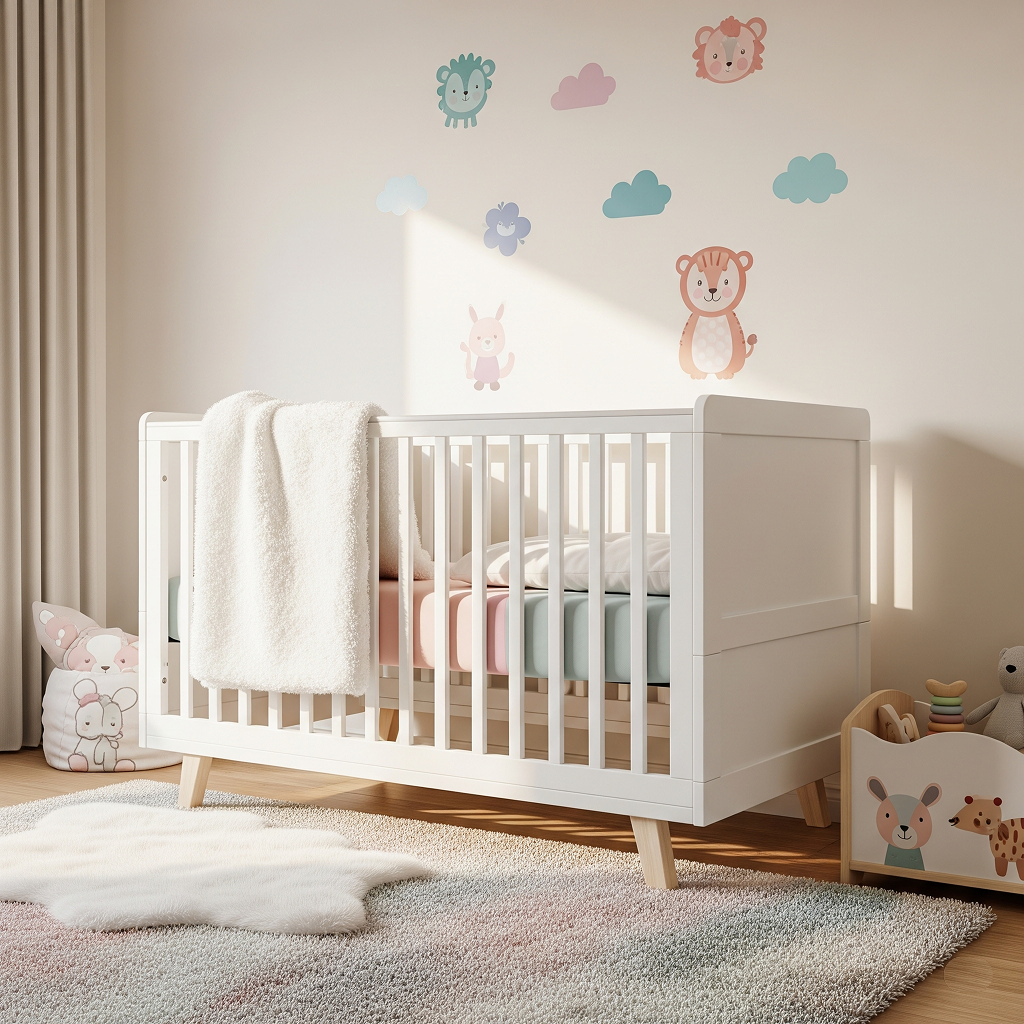Bringing a new life into the world is an adventure filled with excitement, anticipation, and a healthy dose of planning. One of the most joyful and tangible ways to prepare for your baby’s arrival is by creating their nursery. It’s a space where you’ll share countless precious moments, from late-night feedings to morning cuddles. But before you get swept away by adorable themes and paint swatches, it’s crucial to lay the right foundation. The perfect nursery is more than just beautiful—it’s safe, functional, and calming for both you and your little one.
Many parents-to-be dive headfirst into decorating, only to realize later that they’ve overlooked practical essentials. This guide is here to prevent that. We’ll walk you through the foundational steps of nursery prep, ensuring you create a sanctuary that is as smart as it is sweet. Think of this as your ultimate checklist for what to know before a single piece of furniture is assembled or a single wall is painted. By focusing on safety, functionality, and longevity first, the decorating part becomes the truly fun and stress-free final layer.
Beyond Aesthetics: Mastering the Nursery’s Foundation
Before you even think about a color palette or a whimsical mobile, your primary focus should be on the core setup of the room. A well-planned layout and an unwavering commitment to safety are the true cornerstones of a successful nursery. Getting these elements right will save you stress and provide peace of mind long after the new-baby smell has faded.
Safety First: The Non-Negotiable Rules of a Secure Baby Room
You can’t put a price on safety. While it might not be the most glamorous part of the process, creating a secure environment is the most important aspect of preparing your baby’s room. Start with the centerpiece: the crib. Ensure any crib you purchase, whether new or secondhand, meets the latest safety standards from organizations like the Juvenile Products Manufacturers Association (JPMA). This means bar spacing should be no more than 2 3/8 inches (6 cm) apart, and the crib should be free of drop-sides, which are now banned. When you assemble it, follow the instructions to the letter and tighten all hardware securely.
Beyond the crib, think about the entire room as a potential hazard zone for a future crawler and toddler.
- Secure Heavy Furniture: Dressers, changing tables, and bookshelves must be securely anchored to the wall. This is a non-negotiable step to prevent catastrophic tip-over accidents. Anchor kits are inexpensive and easy to install.
- Cover Electrical Outlets: Sliding outlet covers are a fantastic choice as they automatically cover the outlet when you unplug a device, meaning you’ll never forget.
- Manage Cords: Keep all electrical cords, including those for baby monitors and sound machines, at least three feet away from the crib. Use cord concealers to tuck them away neatly and safely. Window blind cords are a major strangulation hazard; opt for cordless blinds or shades for ultimate safety.
- Choose a Safe Location for the Crib: Position the crib away from windows, heaters, lamps, and any wall decorations that could potentially fall.
The Functional Flow: Designing a Layout for Real Life
Imagine it’s 3 AM. Your baby is crying, you’re half-asleep, and you need to navigate the room efficiently and quietly. This is where a logical layout proves its worth. The key to excellent baby room planning is creating a “work triangle” that connects the three main activity zones: sleeping, changing, and feeding.
- The Crib Zone: This is the quietest corner of the room, ideally away from the door to minimize disruptions from the rest of the house. As mentioned, keep it clear of windows and hazards.
- The Changing Zone: Your changing table (or a dresser with a changing pad on top) should be organized for one-handed operation. This means having diapers, wipes, cream, and a diaper pail all within arm’s reach. You should never have to take a hand off your baby while they’re on the changing surface. A nearby hamper for dirty clothes is also a smart addition.
- The Feeding Zone: A comfortable glider or rocking chair is a nursery must-have. Position it in a cozy corner with a small table or stand next to it. This little table is invaluable for holding a bottle, a glass of water for you, your phone, or a book during those long feeding sessions. A dimmable floor lamp nearby will provide gentle light that won’t overstimulate the baby (or you).
By strategically placing these three zones, you create a natural flow that makes caregiving tasks smoother and less disruptive for a sleepy baby.

Smart Investments: Furniture and Storage That Endure
Babies grow astonishingly fast, and their needs change just as quickly. The initial setting up a nursery phase can feel overwhelming, with a long list of things to buy. The secret to managing this is to choose versatile pieces that can adapt as your child grows, saving you money and hassle in the long run.
The Convertible Crib: Your Nursery’s MVP
If you make one significant investment in the nursery, let it be a convertible crib. These multi-functional pieces are the superheroes of baby furniture. A “4-in-1” convertible crib typically transforms from a standard crib into a toddler bed (with a safety rail), a daybed (without the rail), and finally, a full-size headboard and footboard that can be used with a standard mattress frame.
While the initial cost might be slightly higher than a basic crib, the long-term value is undeniable. You are essentially buying a bed that can last your child from infancy through their teenage years. It eliminates the need to purchase a new toddler bed and then another “big kid” bed down the line. It also provides a sense of continuity and comfort for your child as they grow. When making your selection, check if the conversion kits (the rails and hardware needed for later stages) are included or need to be purchased separately.
Beyond the Toy Box: Genius Storage Solutions
You will be shocked by how much stuff a tiny human requires. From clothes in multiple sizes and mountains of diapers to books, toys, and gear, clutter can take over in the blink of an eye. Smart storage is essential for maintaining a calm and organized space.
Think vertically to maximize your space. Tall bookshelves (securely anchored, of course) or cube storage units can house books, bins, and decorative items. Use fabric bins or baskets to categorize toys, making cleanup easier for you now and for your child later.
The dresser is another key piece. A wide, sturdy dresser can easily double as a changing table by simply adding a secure changing pad to the top. This two-in-one functionality saves space and money. Look for a dresser with deep, smooth-gliding drawers. Don’t forget to organize the inside of the closet, too. Adjustable shelves and multiple hanging rods (one high, one low) can double your storage capacity, creating space for clothes, shoes, and back-stock supplies like diapers and wipes.
Creating Calm: Atmosphere, Light, and Sound
The nursery’s atmosphere has a profound impact on your baby’s sleep patterns and overall mood. A serene environment can help soothe a fussy baby and promote longer, more restful sleep—which is the ultimate goal for any new parent. This goes far beyond simply choosing a calming paint color.
Master the Light and Sound for Dreamland
Your baby’s circadian rhythm is still developing, and you can help set the stage for healthy sleep habits by controlling the light and sound in their room.
- Blackout Curtains: These are an absolute game-changer. By blocking out sunlight for daytime naps and streetlights at night, you help signal to your baby that it’s time to sleep, regardless of what’s happening outside. They are one of the most frequently recommended products by sleep consultants for a reason.
- Layered Lighting: A single, harsh overhead light is your enemy. Instead, opt for layered lighting solutions. Install a dimmer switch for the main light fixture. Add a soft, warm lamp on your side table for feedings, and consider a gentle nightlight to make middle-of-the-night checks less intrusive.
- The Magic of White Noise: The womb is a noisy place! A constant, low-level sound can be incredibly comforting to a newborn. A white noise machine can help lull your baby to sleep and, just as importantly, mask abrupt household noises like a dog barking or a doorbell ringing, which could otherwise startle them awake.
A Breath of Fresh Air: Air Quality and Color Psychology
A healthy environment is a happy one. When painting, choose a Zero-VOC (Volatile Organic Compounds) paint. These paints don’t release harmful chemicals into the air, ensuring better air quality for your baby’s developing respiratory system. It’s also a good idea to paint the room several weeks before your due date to allow it to air out completely. If you live in an area with allergens or pollution, a good quality air purifier can provide an extra layer of protection.
When it comes to color, while you might be tempted by bright, stimulating hues, soft and muted tones are generally better for a sleep space. Soft blues, gentle greens, warm grays, and muted pinks can create a tranquil and peaceful feeling. You can always add pops of bright color through accessories like artwork, a play mat, or storage bins. This essential nursery checklist item—a thoughtful color palette—sets the emotional tone for the whole room.
Conclusion: Your Beautiful, Functional, and Love-Filled Nursery Awaits
Preparing for your baby’s arrival is a journey of love, and every step of your nursery must-knows before you decorate journey should be infused with that spirit. By looking past the fleeting trends and focusing on the core principles of safety, functionality, and thoughtful planning, you are doing more than just decorating a room; you are building a haven. You are creating the perfect backdrop for a lifetime of memories.
Remember to prioritize a secure environment, a logical layout, and versatile furniture that will serve your family for years to come. Control the light and sound to create a soothing oasis that promotes restful sleep. Once you’ve built this strong foundation, the creative and personal touches—the art, the textiles, the theme—will be the beautiful final flourishes that make the space uniquely yours. Take a deep breath, trust your instincts, and enjoy the process of creating a welcoming world for your little one.





